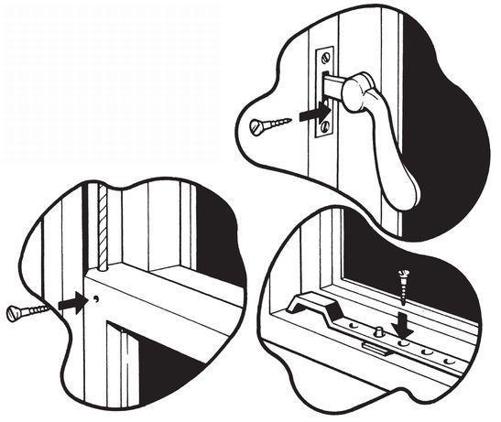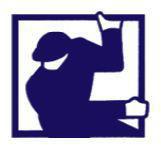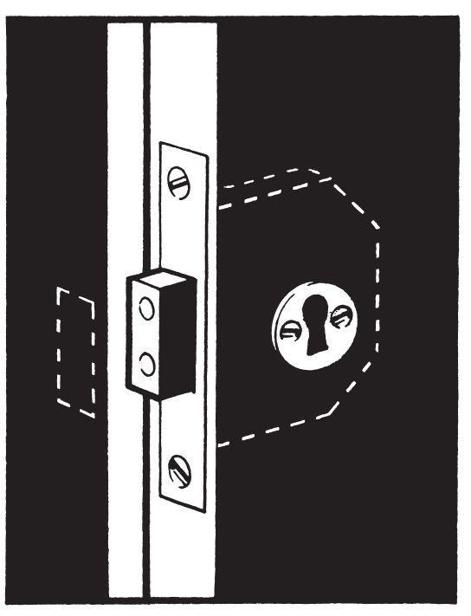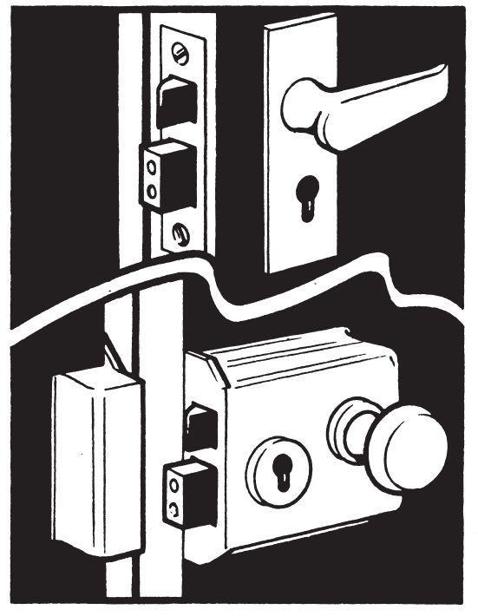SAS Urban Survival Handbook (60 page)
Read SAS Urban Survival Handbook Online
Authors: John Wiseman
Tags: #Health & Fitness, #Reference, #Survival, #Fiction, #Safety, #Self-Help, #Personal & Practical Guides, #General, #Survival Skills

Outdoor illumination of your home should be designed to expose anyone lurking—‘decorative’ garden lighting may offer more hiding places in shadows. A light above or beside a door will show up anyone trying to force locks or break the door open. It will also allow you to see people at night through your security peephole.
A timer or a light-sensitive switch (which is activated when daylight fades) will turn lights on when no one is at home. A better idea for a porch light is to use an infra-red movement detector, which is activated when anyone approaches—a welcome for friendly visitors and an immediate deterrent to someone who does not wish to be seen. The impression given as you step into the field of the detector is that someone has heard you and switched a light on.
Keeping intruders out
Check ALL possible means of entry. Do they have secure locks? The smallest window (in a bathroom or over a doorway, perhaps) may be big enough for a person to wriggle through. Skylights and upper windows are vulnerable if a ladder is used or if there is access from the roof of another part of the building—or even from another building. Even a coal hole or delivery chute may be big enough for a child, if not for an adult. In old houses even chimneys may allow access. Chimneysweeps’ boys used to climb inside them!
When deciding priorities, deal with the ground floor first, then any upper windows near flat roofs, beside a drainpipe or otherwise more accessible. On wood-framed windows you can improvise
temporary
security measures in a few minutes, by inserting screws to prevent latches, catches and staybars from being used.
A temporary measure, if you have sash windows, is to drill a hole through the inner sash and into the outer to hold a screw to prevent the window from being opened. Casement window catches and staybars can also be temporarily immobilized by inserting a screw.

Windows could be firmly screwed shut, but this is inadvisable if the window needs to be used as a fire escape.
DANGER POINTS
- ■
Doors need to be strong, so that they cannot be smashed or kicked in. Glazed panels are a liability—use laminated glass, which is very hard to break. Fit secure locks and bolts—at least a rim lock and a mortise lock (see Door locks). - ■
French windows are easily kicked open if they rely on a single catch. Fit rack bolts top and bottom (see Window locks). - ■
Louvre window panes can be lifted from their fittings. Fix them in place with an epoxy resin glue. - ■
Most domestic glass can be broken or cut. Leaded panes can be removed (almost silently) by peeling back the lead. Double and treble glazing will act as a deterrent, but won’t keep a burglar out. Laminated or wired glass will slow a burglar down, but the only certain protection is a metal grille or shutter outside or a sliding metal grille inside (which can be hidden by a pelmet and curtains). - ■
ALWAYS lock garages/outbuildings—not just to protect the contents but to prevent the use of tools and ladders. Use a toughened-steel security padlock, one with a close-fitting or shielded loop (shank) to make the use of boltcutters difficult. Use coachbolts (with rounded heads) instead of screws to make the fittings more difficult to prise off. If you must use screws, drill out the slots to prevent the use of a screwdriver—or use tighten-only screws. - ■
If ladders are kept outside, chain them to the wall, a fixed pipe or post. - ■
Paint downpipes with security (anti-climb) paint—it remains slippery, making pipes difficult, if not impossible to climb. It’s also VERY difficult to get off the skin and clothing, so the thief will be ‘marked’. - ■
Don’t allow ANYONE the luxury of a close ‘recce’ of your property. If you have a side gate, LOCK IT!
REMEMBER
Keep your glazing putty in good repair. If it is crumbling and can be picked off, the glass can be removed quite quietly. The sound of a window being smashed usually attracts attention.
Building work?
You are particularly vulnerable when building work is in progress—especially if there is scaffolding outside to give easy access. It doesn’t have to be the builders, scaffolders or someone they tipped off about what’s inside—it is obvious to any passer—by that the house is vulnerable.
With workpeople coming and going, it is less likely that even neighbours will realise the house is being burgled. Always INSIST that ladders are hauled up at night and chained to scaffolding, well out of reach of ground level.
Unoccupied houses
Houses left unoccupied for a long period are sometimes stripped of everything—fireplaces, curtain rods, doorknobs, floorboards, stained glass panels. There is a booming market in ‘architectural salvage’! If you move out of your home to allow major work to take place, or delay fully moving in, your furniture, curtains and carpets may disappear! Few people question a removal van being loaded in broad daylight.
Moving in?
The danger is even greater when you are moving into a new house and YOU are unknown to the neighbourhood. Introduce yourself to your immediate neighbours. SOONER OR LATER YOU MAY HAVE TO RELY ON ONE ANOTHER. They will, at least, know that the person climbing through the window is not YOU. Ask them to keep an eye on the place for you, and offer to do the same for them.
How burglars get in
Most burglars enter through ground floor doors and windows. British figures suggest that nearly 50 per cent get in through a side window. About 25 per cent get in through the front door and almost as many by a rear or side door. In many cases, burglars find a door or window unsecured. Forty per cent have to force a door or window, but it’s a lot less likely that glass will be broken to gain entry. Subtler, but less common methods include posing as a tradesman or using a key.

WARNING
The stereotype of the burglar with a sack of ‘swag’, a mask and a torch climbing down a ladder at night is misleading. About half of all domestic burglaries happen during daylight hours – when most people are at work.
Marking property
It is not very common to get back stolen goods. When things are recovered, positive identification of the objects is extremely difficult unless you have photographs and full details.
Make a list of all your valuables. This has to be done when arranging full insurance cover. It will also serve as a check list for losses. For antiques, art objects and valuable jewellery, a photographic record is essential.
Many consumer goods have a serial number—however, these may be removed or defaced. Adding your own marks will identify an object even more clearly. If they cannot be engraved in an unobtrusive place, use a special marker pen with a pigment which glows under ultra-violet light. It won’t be noticeable, unless you know where to look. Use your house number (or the first letters of its name if you have no number) followed by your postal or ZIP code.
BURGLARS’ TOP TEN
 Most burglars are looking for things which are easy to carry and easy to sell. It is obviously much easier to dispose of small antiques, than to find a secret buyer for a painting by Picasso
Most burglars are looking for things which are easy to carry and easy to sell. It is obviously much easier to dispose of small antiques, than to find a secret buyer for a painting by Picasso
or Rembrandt! Plenty of people are only too willing to buy a watch or video recorder that ‘fell off the back of a lorry’. The most common carry-away items stolen include:
- ■
Jewellery/watches - ■
Video recorders - ■
Cash - ■
Hi-fis/radios - ■
Televisions - ■
Credit cards/cheque books - ■
Cameras - ■
Antiques - ■
Personal computers - ■
Silverware
DOOR LOCKS
There are many types of lock, but the most secure are those in which the key trips several levers or tumblers. The key is therefore more complicated to duplicate without a master and the lock is more difficult to pick. Those which have a deadlock action make it impossible to force the bolt back into its casing without turning a key. Most mortise locks are deadlocks. Some rim locks may double as deadlocks, and are activated by an extra turn of the key.
From the inside a securing catch will prevent the opening of any rim lock from outside—even with a key. Most people use the catch to keep the door locked open when they’re frightened of locking themselves out.
Some burglars flip the catch so that no one can open the door and catch them in the act. While you’re fumbling with your key and wondering why it won’t turn, the thief is escaping.
REMEMBER
Do NOT label keys with your address, room descriptions or house numbers. Doing so only helps a thief if he/she gets hold of them.

MORTISE LOCKS
Mortise locks are fitted INTO the door, with the bolthole reinforcement (striking plate) let into the door jamb. These locks MUST be drillproof. The screws are concealed when the door is closed. The bolts MUST have reinforcing pins which prevent them being sawn through.

